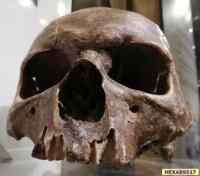 Click on
Click onThumbnail
for
4 photos
Summary
This is the skull of a well-built man probably in his mid to late 40s. Death, providing there were no other fatal injuries, would have been within hours as a consequence of a severe blow to the head with a heavy sharp implement such as an axe. The direction of the wound would suggest he was hit from behind.
Overview
The skull shows angular features and prominent muscle insertion areas consistent with a male. The overall features would suggest a heavily built face with a prominent nose. The sutures are partially fused suggesting an age of around 40 to 50 years. A complete through and through roughly triangular incision is present on the left parietal bone. This latter injury probably occurred just before death.
Cause of Death
The parietal damage with resultant hæmorrhage would have been sufficient to cause death. Absence of bony healing around this would suggest no significant interval between its infliction and death.
(Dept of Oral Pathology, University of Newcastle Upon Tyne, 1992)
1915: “We appreciate Viscount Allendale's kindly thought and interest in presenting to the Abbey as one of its relics the reputed skull of Sir John Fenwick, who was slain at the Battle of Marston Moor in 1644, while fighting on the King's side.” [Hexham Parish Mag. Sep 1915]
1977: Exhibited in a glass case in the North Chancel Aisle “Museum” as item No.50: “Skull of John Fenwick whose Salade hangs in the Nave. A Colonel in the Dragoon Guards, killed at Marston Moor 1644”.
1988: “Museum Committee. It was felt that the skull and helmet [HEXAB2198] should be offered to the Border Museum, it being a more suitable place for the display of these objects.” [Abbey Chronicle, Nov. 1988. PCC News, p.2]
1989: “Agreement between the Rector, Hexham Abbey and Tynedale District Council relating to the loan of the Skull and Helmet of Sir John Fenwick.” [Signed & Sealed 7 Mar. 1989] Transferred to the Border History Museum in the Manor Office, known since 1992 as the Old Gaol.
1990: “A row broke out over the future of the skull of Sir John Fenwick, a cavalier from Hexham, killed fighting for King Charles at the Battle of Marston Moor in the Civil War. The skull was on display in the town's Border History Museum, but some councillors felt that it was in poor taste, and should be given a decent burial.” [Hex. Cour. 24.3.2000 – 10 Years Ago]
“A move to provide a decent burial for the remains of Sir John Fenwick, a Hexham cavalier killed at the Battle of Marston Moor, whose skull had long been on display as an item of curiosity in the Border History Museum in Hexham, was defeated as the grisly relic was regarded as an important piece of Hexham's history.” [Hex. Cour. 20.3.2015 – 25 Years Ago]